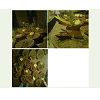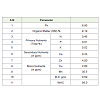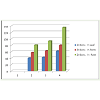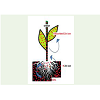Research Article
Cultivation of Hedychium spicatum on ZnAmended Soil: A Phytoremedial Aspect
Vinay Deep Punetha, Ganga Bisht, Deepak Chandra, Nanda Gopal Sahoo*
*Department of Chemistry, DSB Campus, KU Nainital, Uttrakhand - 263002
Corresponding author: Nanda Gopal Sahoo, Department of Chemistry, DSB Campus, KU Nainital, Uttrakhand - 263002,Ph: +91-5942-235055; E-mail: ngsahoo@yahoo.co.in
Citation: Punetha VD, Bisht G, Chandra D, Sahoo NG. Cultivation of Hedychium spicatum on Zn Amended Soil: A Phytoremedial Aspect. J Chem Applied Biochem. 2015;2(1): 114.
Copyright © 2015 Sahoo NG et al. This is an open access article distributed under the Creative Commons Attribution License, which permits unrestricted use, distribution, and reproduction in any medium, provided the original work is properly cited.
Submission: 09/09/2015; Accepted: 16/09/2015; Published: 20/10/2015
Abstract
Zingiberaceae family constitutes a vital group of rhizomatous medicinal and aromatic plants characterized by the presence of volatile oils and oleoresins ofexport value. This study reports capacity of Hedychium rhizomes to absorb Zn from the soil in order to evaluate its phytoremedial potential. Phytoremediationis the direct use of living green plants for in situ, or in place, removal, degradation, or containment of contaminants in soils, sludges, sediments, surface waterand groundwater. For this purpose soils were contaminated artificially by heavy metal Zn at different levels. Zn concentration was determined in various partsafter 120 days. Heavy metal analysis was carried out by the help of Atomic Absorption Spectroscopy. Effect of Zn beside heavy metal plant nutrient in higherdoses (300 ppm) was studied. This experiment was conducted to find out the resistance to such metal element at higher levels in soils and potential of plantsto resist such soil’s toxicity thereby showing normal or good growth in such metal contaminated soils.
Keywords: Hedychium spicatum; Phytoremediation; AAS Spectroscopy
Introduction
Heavy metals as manganese, cadmium, lead and zinc arenaturally present in the environment. Their presence has graduallybeen increasing with the increase of industrialization. Themobilization of heavy metals by man (through mining from ores andprocessing for different applications) has led to the contaminationof different environmental segments by these elements. Thereforethe phytoremedation of heavy metals from soil is essential.Phytoremediation is defined as the use of green plants to removeheavy metals and contaminants from the soil [1-3]. It is adopted asit offers a low cost and an environmentally friendly approach forthe treatment of soils. Excessive amount of Zn in soil may affectplant adversely as Zinc at high concentrations is documented as celldivision inhibitor [4].
In present study Hedychium rhizomes were chosen to evaluateeffect of heavy metal concentration on the plant of Zingiberaceaefamily. This family constitutes a vital group of rhizomatous medicinal and aromatic plants characterized by the presence of volatile oils andoleoresins of export value [5]. Hedychium is one of the plant specieswhich is commonly used in preparation of indigenous medicine. Therhizome extract, contains essential oil, starch, resins, organic acids,glycosides, albumen and saccharides, which is administered for bloodpurification, bronchitis, indigestion, treatment of eye disease andinflammations [6]. Studies on phytoremedial potential and potentialto resist heavy metal pollution beyond its nutritive value provides anopportunity to exploit Zn contaminated soil for the production ofHedychium cultivation.
The phytoremediation of metal-contaminated soils provides acheaper way for soil remediation. Because the costs of growing a cropare minimal compared to those of soil removal and replacement, theuse of plants to remediate hazardous soils was seen as having hugeimportance. In addition it will provide an opportunity to exploitcontaminated soils for their agrarian utility. Phytoremediationgenerally has a low remediation rate, and usually require a longerperiod [7,8].
Various factors can be calculated based on the concentration ofheavy metal ion in different parts of the plants. Translocation Factoris a parameter which indicates the ability of the plant to translocatemetals from the roots to the aerial parts of the plant [9]. Translocationfactor is ratio of metal concentrations at the aerial parts and in theroot respectively. Translocation factor is a key parameter whichreveals affinity of metal ion for either aerial parts or root [10].
TThe aim of present study is to determine the effectiveness ofphytoremediation for the removal of Zn using Hedychium spicatumrhizomes. Soil samples were collected at a depth of 20 cm from theproject site Dhari, India. Pots were contaminated with differentconcentration of Zn. Experiment conducted in order to observethe tolerance of plant species toward the Zn contamination in thesoil and to analyze efficacy of the plant for the detoxification of soil contaminated with Zn.
Material and Methods
Test Plants
Plants seedlings were purchased from regional centre of NBPGRsituated in Bhowali (Distt. Nainital). After cultivating them into thenurseries (Figure 1) and were transferred into experimental pots inwhich Zn metal was amended at different concentrations.
Collection of Samples
These samples were analysed before the Zn contamination.Samples were air dried, grinded into fine powder using pestle andmortar and passed through 2 mm sieve. The soil samples were preparedfor physio-chemical analysis. In addition soil samples were also takenfor evaluation of physiochemical properties. Inferences were drawnon the basis of evaluation of some parameters chosen like pH, organicmatter, primary nutrients (N,P and K), secondary nutrients like (Ca)and micronutrients Zn, Cu , Mn in addition electrolytic conductivity,bulk density, water holding capacity (WHC), soil colour, texturewere also evaluated. (this part of the study was conducted at soilanalysis laboratory, Niglat, Bhowali). The fresh rhizomes of the plantmaterial was collected from project site, during middle of October2012 after 120 days of Zn amendments into the soil. Various parts ofthe plant were separated, and cleaned properly. These samples werelater evaluated for the determination of phytoremidial potential bydrying and grinding into fine powder.
Digestion of various collected samples
The samples of Hedychium spicatum were collected in the monthof October 2012 seasonally with random sampling. Leaves, stem androots were dissected. Digestion process was carried out according toSasmaz and Obek. The plant samples were dried at 80 °C for 20 hand the ash contents were determined by heating at 480°C for 4 h.HCl (2.0 mL, Merck), HNO3 (2.0 mL, 65%, Merck) and H2O2 (2.0 mL,30%, Merck) were added to 2.0 g ash and the mixture was heated at95°C hot plate for an hour [11].
Water samples for heavy metal analysis
Method adopted for this purpose was EPA (EnvironmentalProtection Agency) vigorous digestion method described by Gregg.Sample left after distillation of plants were transferred into 500 mL beaker containing 50 mL of conc. HNO3. The sample were boiledslowly and then evaporated on a hot plate to the lowest possiblevolume. The beaker was allowed to cool and another 25 mL of conc.HNO3 was added. Heating was continued with the addition of conc.HNO3 as necessary until digestion was complete. The samples wereevaporated again to almost dryness and the beakers were cooled,followed by addition of 1:1 v/v HCl solution. The solutions were thenwarmed with 5mL NaOH (5M ), then filtered through WhatmannFilter Paper No. 42. The filtrate was transferred to 25 mL Volumetricflask with distilled water [12].
Results and Discussion
Observations made after analysis of the soil has shown (Table 1) thatthe soil “A” was slightly acidic in nature holding pH of 6.9, slightly acidicnature of the soil which has more H+ ions in the systems accountsfor better cation exchange capacity (CEC), consequently making themetal to be more bioavailable to the plant. The percentage of organicmatter in the soil was 9.19%, primary nutrients N,P,K present in thesoil were 0.45, 0.01 and 0.02 total % respectively. Secondary nutrientCa was 0.233% while micro nutrients Zn, Cu, Mn, were found to be8.2, 5.0 8.58 ppm respectively. Bulk density of soil was found to be0.95 g cm-3 while WHC was 95%. Micro nutrients like Cu, Zn, Mnwere present 4.0, 2.6, 30.5 ppm respectively. Certain parameters suchgood amount of organic content, moderate water holding capacityand pH slightly in the acidic range (6.9) are the factors which are goodfor the cultivation of Hedychium spicatum.
Absorbed metal concentration was analyzed by Atomic AbsorptionSpectroscopy (Atomic absorbtion spectrophotometer, Model 4129,Electronic Corporation Limited). This study has shown that Rhizomesof the Hedychium spicatum can take up Zn metal and accumulatethem in other parts of the plant. Metal distribution in various partsof the plant at different concentrations has shown that rhizome hascapability to accumulate heavy metal. Though at high concentrations(300 ppm) leaves has shown effect of metal toxicity as they turn yellow.Concentration of heavy metal quantified in various parts of plant hassuggested Hedychium rhizomes have more tendencies to accumulate Zn ions into their roots. As it is explicit from the experiment thatin various Zn amended soils, concentration of Zn is always more inthe rhizomes, which suggests metal availability and mobility in therhizosphere gets influenced bioavailability of the metal ion. (Figure 2) The accumulation of heavy metals in roots, stems and leaves wereestimated separately. Concentration of heavy metal quantified invarious plant parts has suggested Hedychium rhizome has strongtendency to accumulate Zn ions into their roots. As it is explicit fromthe experiment that in various Zn amended soils, concentration ofZn is more in the rhizomes in each experiment. As the pH of soil isless and slightly acidic, it assists in the exchange of metal ions andmore absorption of metal ion takes place from the soil. In all threeconcentrations Translocation Factor is less than one which indicatesthe ability of the plant to accumulate metals ions in the roots of thespecies in comparision to that of other baerial parts of the plant. Onthe basis of this study Hedychium spicatum could be classified as ahyperaccumulator for Zn metal, though other necessary parametershave to be evaluated experimentally in order to confirm this study.Roots have more accumulation capacity as compared to stem andleave, the metal ions present in the soil are in the direct contact of theroots, and hence their bioavailability for roots is more than that ofother plant parts. As evidences suggest phyto-accumulation popularlyalso known as phyto-extraction could be the possible mechanism ofmetal absorption. (Figure 3) This study could turn significant as itshows applicability of Hedychium for the decontamination of Zn andits potential to survive on Zn contaminated fields which extends itsapplicability in the field of phytoremidation beyond its traditional usein the field of pharmaceutics.
Acknowledgement
Authors are thankful to Defence Institute of Bio-Energy Research(DIBER) Pithoragarh, for their kind assistance for the AAS detectionof the soils. We are really thankful to GBPIUT, Kosi-Katarmal forproviding the financial support to this research work.
References
- Zheljazkov VD, Nielsen NE (1996) Effect of heavy metals on peppermint and cornmint. Plant and Soil 178: 59-66.
- Salt DE, Blaylock M, Kumar NPBA, Dushenkov V, Ensley BD, et al. (1995) Phytoremediation: A Novel Strategy for the Removal of Toxic Metals from the Environment Using Plants. Nature Biotechnology 13: 468-474.
- Rahimi M, Farhadi R, Balashahri MS (2012) Effects of heavy metals on the medicinal plant; International Journal of Agronomy and Plant Production 3: 154-158.
- Davis MS, Francis D (1991) The influence of an inhibitor of phytochelatin synthesis on root growth and root meristematic activity in Festuca rubra L. in response to Zinc. New phytol 118: 565-570.
- Bisht GS, Awasthi AK, Dhole TN (2006) Antimicrobial activity of Hedychium spicatum. Fitoterapia 77: 240-242.
- Reddya PP, Tiwari AK, Rao RR, Madhusudhan K, Rao VRS, et al. (2009) New Labdane diterpenes as intestinal α-glucosidase inhibitor from antihyperglycemic extract of Hedychium spicatum (Ham. Ex Smith) rhizomes. Bioorganic & Medicinal Chemistry Letters 19: 2562-2565.
- Tangahu BV, Abdullah SRS, Basri H, Idris M, Anuar N, et al. (2011) A Review on Heavy Metals (As, Pb, and Hg) Uptake by Plants through Phytoremediation. International Journal of Chemical Engineering 2011: 31-34.
- Salt DE, Smith RD, Raskin I (1998) Phytoremidation. Annual Review of Plant Physiology and Plant Molecular Biology 49: 643-668.
- Marchiol L, Assolari S, Sacco P, Zerbi G (2004) Phytoextraction of heavy metals by canola (Brassica napus) and radish (Raphanus sativus) grown on multicontaminated soil. Environ Pollut 132: 21-27.
- Mellem J, Baijanth H, Odhav B (2009) Translocation and accumulation of Cr, Hg, As, Pb, Cu and Ni by Amaranthus dubius (Amaranthaceae) from contaminated sites. J Environ Sci Health 44: 568-57
- Sasmaz A, Obek E (2009) The accumulation of arsenic, uranium, and boron in Lemna gibba L. exposed to secondary effluents. Ecological Engineering 35: 1564-1567.
- Gregg LW (1989) Water analysis Handbook. HACH Company, US: 33.




